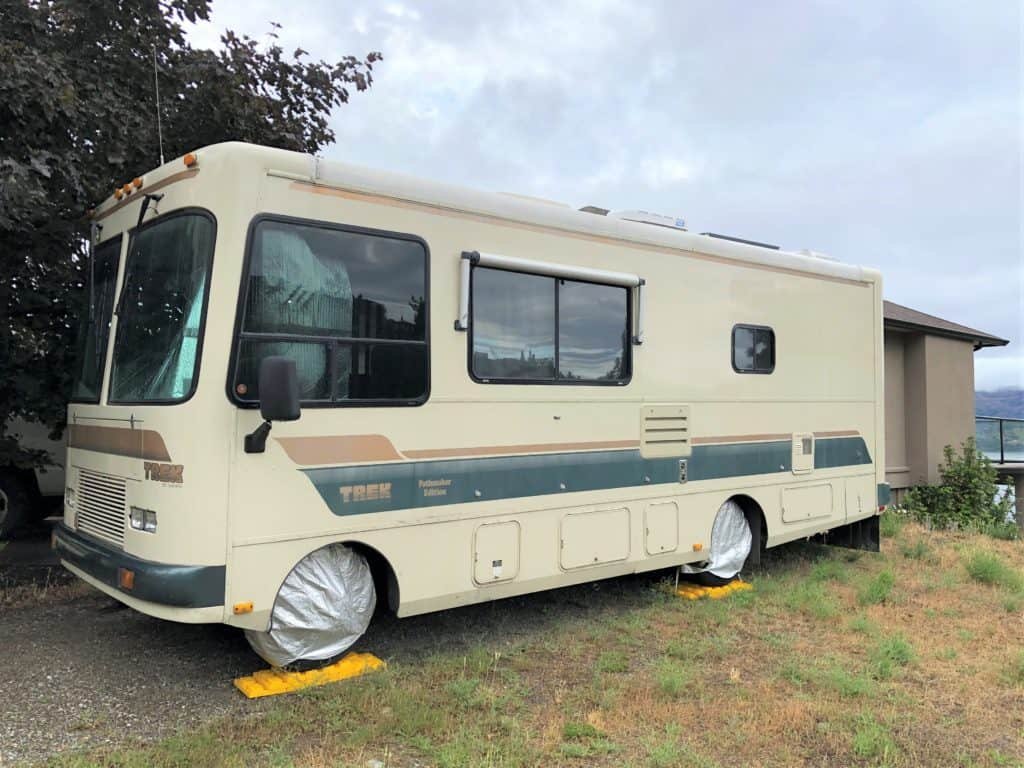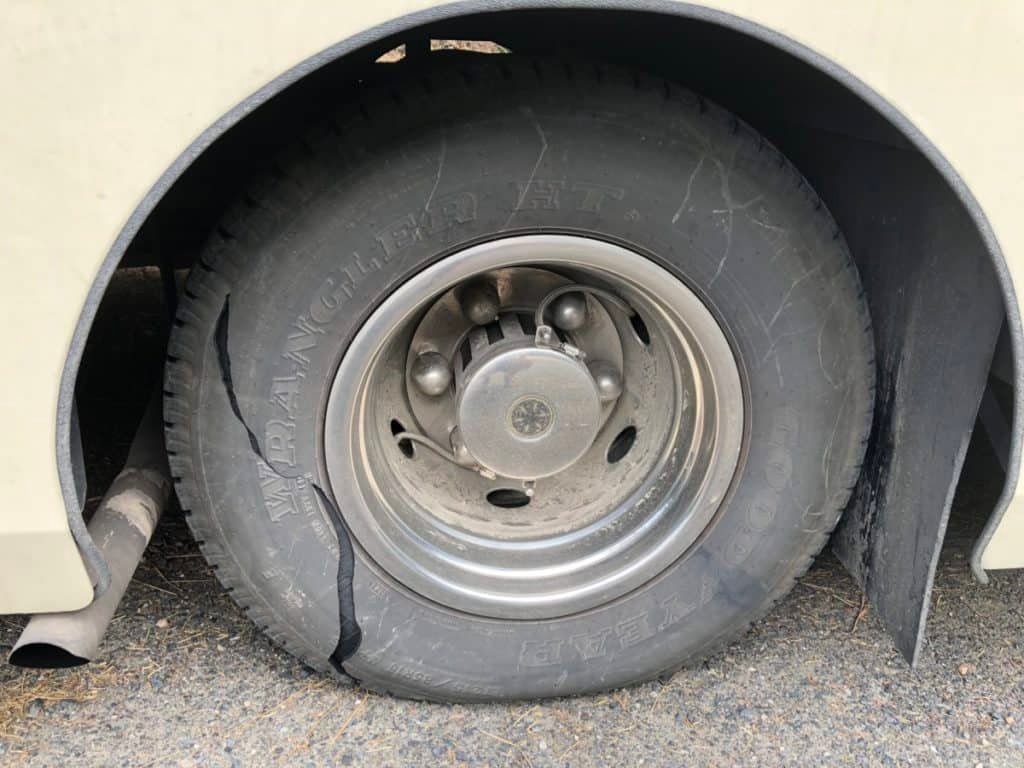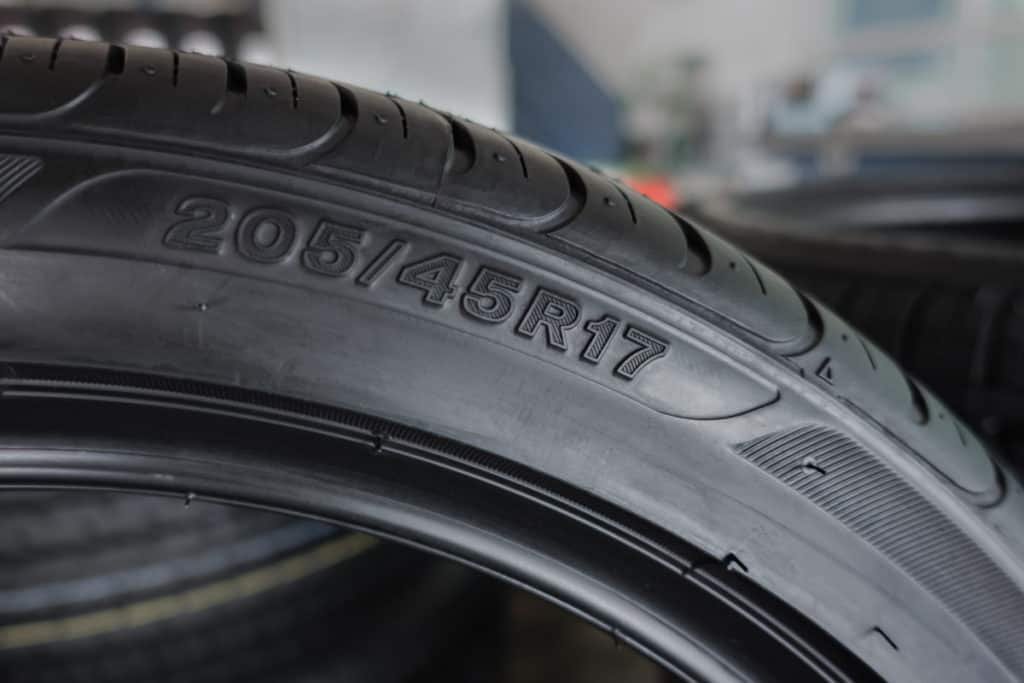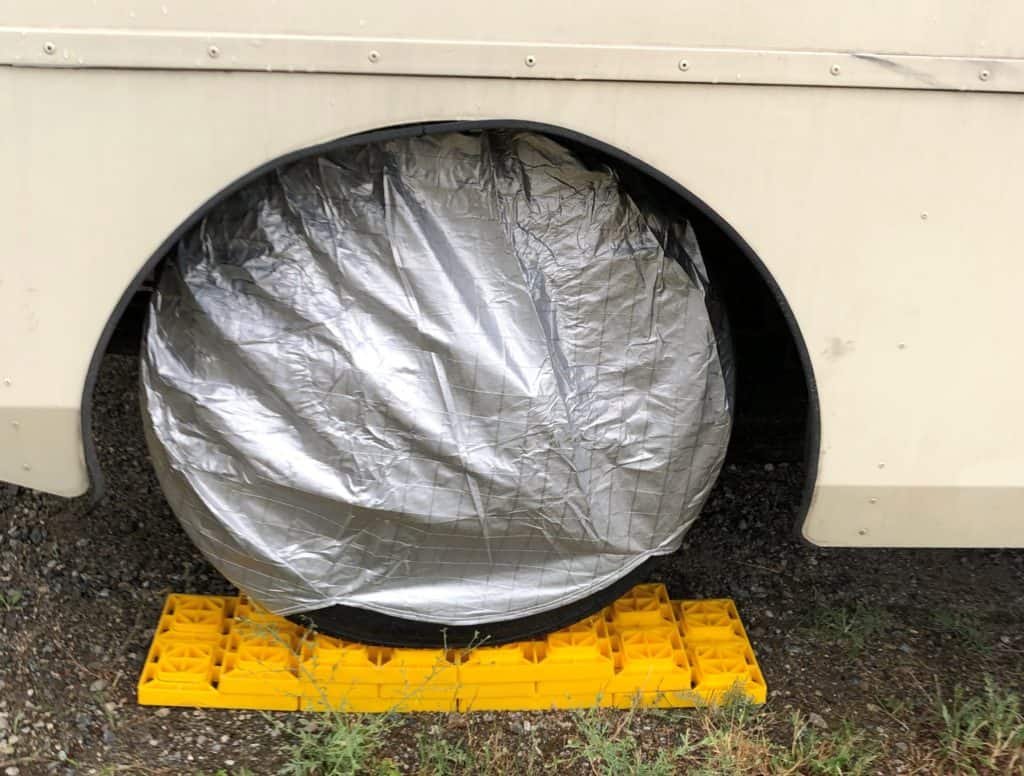This post contains affiliate links.

During one of our trips, we were unlucky enough to experience a tire blowout. Fortunately, it was relatively uneventful and we were able to safely get off the road. But we did spend a lot of time waiting for roadside assistance and the tire we got sure wasn’t cheap. The tire guy recommended covering our tires to help them last longer.
So, why should you cover your RV tires? If your RV is parked for an extended period of time, it’s important to cover your RV tires to protect them from UV rays and extreme weather conditions. UV rays can prematurely crack the sidewalls of your tires.
Your RV’s tires are one of the biggest factors when it comes to road safety. They are also an expensive factor. Covering your tires can help to extend the life span of your tires for a relatively small amount.

If you are interested in learning more about what causes tires to blow out and how to prevent it, aside from covering your tires, read our article on Why RV Tires Blow Out And How to Prevent It.
Table of Contents
Covering Your Tires
Like people, tires are subject to the harmful effects of the sun. UV rays can damage your tires’ rubber if exposed for extended periods of time.
Tires have a built-in UV protection in the rubber but the tire’s sidewall needs to be heated and flexed to bring the additive to the surface. This occurs when a vehicle is driven frequently, like a car, and the tires are continually being rotated and warmed by the friction from the road.
The sun can cause chemical changes within the rubber of the tire reducing flexibility. Cracks in the sidewall can occur prematurely if exposed to excess sun increasing the possibility of a blowout.
Heat is also a factor that can cause your tires to deteriorate faster. Tire covers can reduce the amount of heat that will penetrate into your tires.
While it’s hard to know if damage has occurred in your tires it’s important to note that damage caused by UV and heat may double for every 16 deg Fahrenheit increase in temperature.
These are the tire covers we purchased for our RV.
- ★ Premium Material: Amfor rv tire covers Constructed with a 4-layered heavy-duty aluminum material: PE&PEVA for waterproofing against rain...
- ★ Wind-resistant fastener Design: Elasticized band with a hook and windproof buckle, ensuring a secure fit that prevents the trailer wheel...
- ★ Determine tire diameter: Determine tire diameter: If your tire is written with 205/75/14 , Then A=205 B=75 C=14 Tire...
Selecting Tire Covers
There are many different tire covers available on the market these days. To help you select the best cover for your RV there are several factors to consider including size, material, style, and price.
Tire Cover Size
Picking the right size cover for your tires is probably the most important and simplest way to start narrowing your search for the right tire cover.
If your cover is too big it will sage and moisture can pool in pockets of fabric. If it’s too small it simply won’t fit.
There are two ways to find the diameter of your tire, directly measuring the tire or calculating it from the tire size.
If you have your RV handy the easiest way is to use a tape measure and directly measure the diameter (the widest part) of your tire. The diameter of our tire is 27 inches
You can calculate the diameter of your tire using the tire size printed on the sidewall. For example, our RV has 215/85 R16 printed on the sidewall. Meaning out our tire is 215mm wide, has a ratio of side height to tire width of 65% and a rim diameter of 16 inches.

To calculate the total diameter of your tire you need first convert your tire width to inches (there are 25.4mm in an inch) then use the following equation.
D = Rim Diameter x 2(Tire Width X Ratio)
For our tire: D = 16 x 2[(215/25.4)x0.65] = 27 inches.
So I would need to look for a tire cover that will fit a tire with a 27 inch diameter.
Tire Cover Material
Buying covers made from high quality, durable material will help your cover last longer. That being said, basically, any tire cover on the market will protect your tires from UV rays.
You do want to invest in covers that are water-resistant or, ideally, waterproof to prevent water seeping into the material and sitting on your tire. Airflow around the tire will help prevent moisture build-up underneath the cover.
Covers are mainly made from vinyl, aluminum film or canvas.
The vinyl used is heavy-weight with flannel backing and comes in black or white and sometimes grey. Some RVers choose to go with a black or grey option to hid any dirt that is bound to accumulate.
All colors will prevent UV rays from getting to your tires but darker colors tend to heat up more than lighters colors. So if you are traveling to hot places white covers will be a better option to keep your tires cooler.
Canvas covers will be water-resistant, not waterproof but will allow better airflow through the material and around the tires.
Aluminum film material is typically backed with soft material such as cotton or felt. A benefit to the aluminum film is it will reflect the sun and reduce the amount of heat that is transferred to the tires underneath. We opted to purchase these inexpensive aluminum film tire covers from Amazon.

Tire Cover Style
There are two types of tire covers available on the market bag style and shield style. Bag style is the most common and goes over your tire like a bag. Shield style ones that act as a curtain for your tire.
Bag style has the advantage of covering the entire tire providing better temperature insulation while still allowing some air circulation. These can be more of a pain to put on since the bag needs to go over the top of the tire and be secured behind the tire, sometimes with a bungee cord.
Shield style provides better air circulation around the tire but will only cover the sidewall of the tire. These tend to be easier to put on since they install with suction cups or snaps.
Another consideration is if your RV is dual or tri-axel. You can purchase separate covers for each tire or get one that will cover all tires at once.
The advantage of buying a cover that protects all your tires is it allows better airflow between the tires. The downside though is these covers tend to be a bit pricier.
Tire Cover Price
Like everything on the market today, there is a huge range of prices for tire covers. A set of four single tire covers ranges from $5 up to $87. For a single dual axel cover, they average around $25.
Just because something is the most expensive, doesn’t mean it’s the highest quality or longest lasting. Once you’ve narrowed down what you are looking for in a cover then price point and buyer reviews are the final steps to picking your cover.
When to Cover Your Tires
You should cover your tires when you are parked for an extended period of time. Now, extended can mean different things to different people.
In general, if you are going to be stationary for a week or more it is good practice to cover your RV tires.
When you put your RV into storage you should definitely protect your tires with covers if it’s going to be parked outside.
Even in the winter UV rays can still damage your tires. Covers will also protect against extreme cold and weather that might occur in the winter.
Do You Really Need Tire Covers?
There is an ongoing debate in the RV world whether tire covers are actually worth it or not. Some are 100% for using covers while others don’t think they matter.
There are a few things that you really need for your RV. It’s up to you to decide if tire covers are worth it to take up precious space.
It’s hard to know 100% how big of an effect the sun had on the life span of your tires since there are many factors that contribute to tire dry rot.
But if a $50 investment can possibly extend the life of your tires even by a little then why wouldn’t you?
Related Questions:
What is tire dry rot? Tire dry rot is a form of decay that happens as tires age. It is accelerated when a tire is exposed to UV rays and high temperatures. It is also known as sidewall cracking.
Can I make my own RV tire covers? While it’s possible to make your own tire covers, it’s much less expensive and time-consuming to purchase them already made.
How long do RV tires last? Tread depth and mileage are not necessarily good indicators of the “health” of a tire. Tires have a life span of 6-10 years, that’s from the manufacturing date. Car manufacturers recommend replacing tires 6 years after production. Some tire manufacturers say their tires can last up to 10 years but require you get an annual inspection after 5 years. Learn more about buying RV tires in our buyers guide How to Choose RV Tires.
Recommended Tire Products
- Digital tire tread depth gauge (Amazon) is an inexpensive and handy tool to help you keep an eye on your tire health
- RV tire pressure monitors (Amazon) are an inexpensive and simple way to check your tire pressure quickly during your daily walk around. Make sure to buy ones that show the right tire pressure for your tires.
- Portable Air Compressor (Amazon) a real lifesaver when the nearest service station is an unknown distance away. This one is perfect for RVs can reach more than 100 psi and can even be directly connected to your battery


